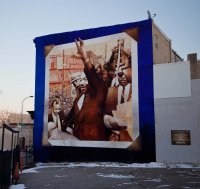Guiding Students to Drive Their Curriculum
A structured framework for engaging middle school students in planning out their own lines of inquiry.
Your content has been saved!
Go to My Saved Content.The last few days before winter break are often a wash. Students—and teachers—are exhausted and distracted. This year, however, the fifth and sixth graders at Science Leadership Academy Middle School (SLA-MS) in Philadelphia were more engaged than ever.
On the last school day of December, we had students collaborating, debating ideas, writing furiously, and standing on chairs to proudly present their thinking. One student exhorted his peers, “Listen up, because this matters for all of us.”
These students were voting to define their own curriculum for the remainder of the school year. There’s no question that we need to value student voice in classrooms. But how do we shift from creating space for student voice to centering student ideas and creating curricula with students? At SLA-MS, this question has guided the development of Humanities content organized around our yearlong theme, bravery.
Bring in Student Experience From the Start
Before arriving at that vote before winter break, we needed to build common ground within our classroom. In order to create an equal footing for our 180 students, all with their own experiences and background knowledge, we started with something each student is uniquely expert in: themselves.
The first project of the year was a literacy autobiography in which students thought about their personal connections to bravery. They interrogated moments in their lives when they needed to be brave as readers, writers, speakers, or listeners. In sharing this work, students got to know one another other as learners, and they created a shared definition of bravery.
In their second project, students worked in small groups to create a guide to being brave in middle school. Their research for this project included reading the same fiction books as a class and identifying commonalities in their middle school experiences up to that point.
But learning through reflection and building community are not simply exercises for the first six weeks of school—they’re methods we can use continuously to help build a culture based on learning from one another.
Build Shared Background Knowledge
These first projects emphasized that students can learn by reflecting on themselves and by reflecting with their peers. But when it comes to historical content, we couldn’t expect students to learn out of the ether. As teachers we needed to create structures for students to research and discover, authentically.
At SLA-MS, this work happened with our third project of the year: Bravery in the Neighborhood. Each class of Humanities students explored our school’s neighborhood in West Philadelphia. This included structured observational walks, internet research, conversation, and written reflection coming from our experiences.
Through our shared research, we identified sites that represented historical bravery. These ranged from the location where Martin Luther King Jr. gave his “Freedom Now” speech to murals on the side of our local library branch highlighting the Lenni Lenape, who once made up the majority of the area’s population. Students researched these sites—with help from teachers—and took their research through a writing process to create podcasts that we strung together as an audio tour of the neighborhood.
Across the classrooms, students became experts in different aspects of our neighborhood’s history. With teacher-created structures, students were able to identify topics of interest, explore these deeply, and create a lasting artifact that others, including their peers, learned from.
Create Shared Inquiry With Students
Interest drives motivation in learning. Ultimately, students want to explore questions and topics they care about and see as important. We also know that students, particularly middle school students, crave belonging. They need to feel that they belong in their school and in their classroom community. Being part of group decision making helps create that feeling. In guiding students to work together—whether in small groups or as a whole class or even a whole grade—we can identify what matters and craft this into essential questions that propel future units of study.
In our case, we used information from our walk to create a timeline of historical bravery in our neighborhood. Through activities focused on noticing and wondering, students pulled out major themes they saw in the timeline. We defined importance and used the definition to create pitches for the themes we were considering focusing on for the rest of the year.
On the final day before winter break, students voted as we whittled down our original list of more than 30 themes until we were left with these four: War, Civil Rights, Freedom, and Changes Over Time.
These themes were our lines of inquiry for the spring. How do individuals become braver over time? How do societies become braver over time? We used the American Revolution as a lens, followed by civil rights in the U.S., using the questions: What does it mean to fight for freedom? In each context, who is free as a result? Who isn’t?
Curricular freedom is a gift when trying to cocreate with students. But even with most required content or sequences of topics, we can still center students’ ideas by starting with personal connections, building shared background knowledge, and determining what matters in order to ask and explore our next set of questions.
When we help students drive the curriculum, they see themselves as the ones with the knowledge and the ones eager to do the learning.
